
|
|
Ohio66 presents an in-depth look at the circumstances surrounding the departure of George Maharis from route 66 in the middle of the third season.
TALK ABOUT PUTTING THE SHOW ON THE ROAD!
The ‘Route 66’ crew has logged more than 19,000 miles traveling to 36 different locations.
There is not a single paved street in the hot and dusty little town of Cordova, N.M., nor a straight one, nor a level one, nor a wide one. Nor a long one. Hidden in a small vale off Highway 75, some 40 miles north of Santa Fe, it boasts an adobe church dating back to 1830, a collection of adobe huts surrounding a rutted dirt square and a population of 451 citizens of Spanish heritage, a large number of them black–haired, black–eyed, olive–skinned children with shining white teeth and grins from here to there.
On a warmish spring afternoon late this past April, the normally sleepy square was alive with activity. The cast and crew of TV’s only nomadic dramatic series, Route 66, had taken the place over. Half the population, plus one tired—eyed burro, had ringed itself happily around the cameras. Martin Milner, one of the show’s two co—stars, was delivering a dramatic speech to actor Thomas Gomez, imported from Hollywood for the occasion to play the patriarch of a small New Mexican town. Mr. Gomez had “kidnaped”[sic] Mr. Milner on a trumped-up traffic charge and had just sentenced him to teach the town’s children, the town being without a school, for a year.
Halfway through Milner’s impassioned speech, which he was now doing for fourth time, a group of Cordovans, impressed as extras for the occasion, broke into a fit of giggles. Milner stopped, straightened up and stared rover at the offending amateurs. “Shut up!” he roared. There was an instant silence and the scene was begun over again.
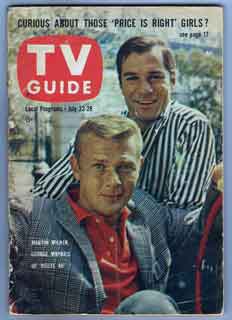
“You meet all kinds of people on this show,” Milner said when the scene was finally finished. “Nice people, most of them. These are nice people. But when you have several hundred of them as an audience, especially an audience that doesn’t understand the first thing about film—making, you sometimes have to crack a whip.”
He gazed around at the Cordova surroundings and shrugged. “Trouble with this place, it looks exactly like the Mexican town on the back lot at Republic. We knock ourselves out to put authentic backgrounds and sets on the air and then the wise guys watch the show and tell their neighbors how the whole thing is faked in Hollywood.”
Milner contends they knock themselves out for authenticity and then the wise guys say the whole thing was faked in Hollywood
Since it first took to the air early last October, Route 66 has traveled to 11 states, ranging from Kentucky and Ohio, through Louisiana and New Mexico, to Nevada and Oregon, filmed episodes in 36 different towns and cities and racked up a total of 19,288 miles for its three equipment trucks alone—not counting mileage in and around the various locations.
The object, brainchild of producer Herbert B. Leonard, was to do a TV series entirely on the road, telling the story of two itinerant young Easterners trekking westward in a sports car. Milner plays a young and recently orphaned Yale man, George Maharis a near-hood off the streets of New York. The sports car, felicitously, is played by the sponsor’s product.
The most cherished accolade in the TV rat race these days is a renewal for another year. Route 66 has such a renewal. It has not changed its format one iota in the 32 episodes filmed for the season (with repeats, it will run through the summer, pick up with new shows in the fall). Producer Leonard attributes its success simply to the fact that “it’s a good show.”
Milner and Maharis, satisfied actors who believe producer knows the answers
Both Milner and Maharis back up their producer, almost belligerently. Dust-covered and sunburned, Milner tucked his long legs up under his chin on the drive back to Santa Fe and snorted a disavowal of any I’ve-had-it feeling about the show.
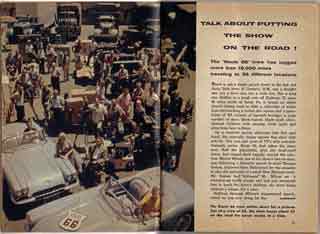
“We’re doing it the way it should be done,” he said, “and it would be very easy to have done it all in Hollywood. I figure to give it four more years; By that time I will have had an education on the road and my daughter Amy will just be starting in school. I want to be home for that.”
Furthermore, I’ll have enough in the bank by then to be able to do what I want to do, maybe even take a year off and go around the world with Judy and the girls.” (Married to former singer-actress Judy Jones, Milner has two daughters, Amy, 3, and Molly, 6 months).
Maharis, who did not make the Cordova outing, stood in the lobby of Santa Fe’s La Fonda hotel (once described as the most elegant adobe hut in the world), spread his feet and challenged a Hollywood newsman to deny that Route 66 was setting a precedent. Maharis talks with his eyes, his mouth and his fists, punching at the air and sometimes the man he is talking to. He is probably one of the most dangerous conversationalists in the acting profession.
“It’s a precedent,” he said for the fourth or fifth time. “Tell me another show that’s done it. Bet me that 10 other new shows won’t be doing it in another year or two. It’s crazy, man. We’re doing it.”
Milner, who had been acting since he was 14 and largely in family shows (he was one of the red-haired Day boys in the “Life with Father” feature picture, played the gangling boy-suitor in both Trouble with Father and The Life of Riley), is as devout a family man as any doting viewer could wish to admire. He calls home every night, collects antiques, talks constantly about his two daughters. “It’s beginning to scare me,” he brooded. “Our next-door neighbor’s little girl was bragging about her father the other day and Amy said defensively, ‘I have, a Daddy too.’ Thing[s] like that gets to you.”
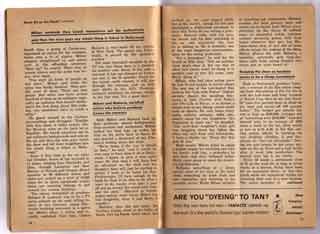
Next season, Milner plans to equip a station wagon for traveling and take the family with him, a procedure he and Judy and Amy followed before Molly came along to upset the traveling togetherness.
Maharis, something of a loner, spends most of his time in his hotel room, munching on fresh fruit and raw vegetables and listening to his portable stereo. While Milner delights in searching out restaurants, Maharis invades the local grocery store and stocks up on health food. Milner plays shortstop on the Route 66 softball team (a successful public relations venture involving games with local teams wherever they go), but Maharis steers clear of any and all team efforts except the making of the films. Milner phones his wife. Maharis, a bachelor, constantly gets long-distance calls from young females he’s never met or even heard of.
Keeping the show on location seems to be a cheap investment
Back in Hollywood, producer Leonard, a veteran of six film series ranging from Adventures of Rin Tin Tin to both the half—hour and hour versions of Naked City, likes to say that Route 66 “costs five percent more to shoot on the road and comes off 100 percent better.” The budget per episode has run as high as $160,000, averages out at “something over $110,000.” Leonard himself puts in an average of 5000 miles a week in the air, often works as late as 4:30 A.M. in the film cutting rooms, admits to knowing his two children (Shelley, 5, and Stephanie, 3), “but not intimately? During the past season he got every episode on the air three and a half weeks after it went into production. The normal time lag is six weeks.
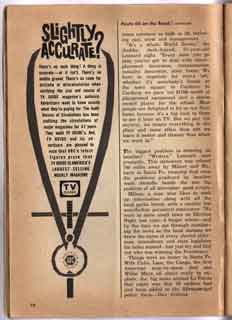
Route 66 keeps a permanent crew of 35 on the road for as long as seven weeks at a stretch, flying them back for an occasional three- or four-day break while the equipment trucks are wheeling their way to a new location. The entire company at times numbers as high as 50, including cast, crew and management.
“It’s a whole World Series,” the chubby, dark-haired, 37—year-old Leonard sighs. “Every state you go into, you’ve got to deal with unemployment insurance, compensation, casualty insurance, state taxes. We have to negotiate for every ‘set,’ whether it’s somebody’s house or the town square in Cordova, In Cordova, we gave ’em $1700 worth of playground equipment and a stereo record player for the school. Most people are delighted to let us use their home because it’s a big kick to them to see it later on TV. But we pay ’em anyway, we insure everything in the place and more often than not we leave it neater and cleaner than when we went in.”
The biggest problem in shooting on location? “Writers,” Leonard says promptly. This statement was echoed 740 miles away by Milner and Maharis in Santa Fe, meaning that even the problems produced by locations work dwindle beside the one big problem of all television: good scripts.
Milner, a man who likes to soak up information along with all the local garlic bread, adds a smaller but nonetheless persistent annoyance. “We were in some small town on Election Night last year—I forget where—and by the time we got through monitoring the news on the local stations we knew the name of every elected alderman, councilman and state legislator for miles around—but just try and find out who was winning the Presidency?
Things were no better in Santa Fe. With Cuba, Laos, the Congo, the first American man-in-space shot and Willie Mays all about to explode, the big news around La Fonda that night was that 19 rookies had just been added to the Albuquerque police force.-—Dan Jenkins.
TV Guide - July 22, 1961
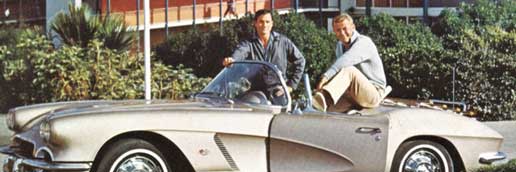
If you are a Route 66 fan, please consider joining the discussion group at:
groups.io Route 66 TV